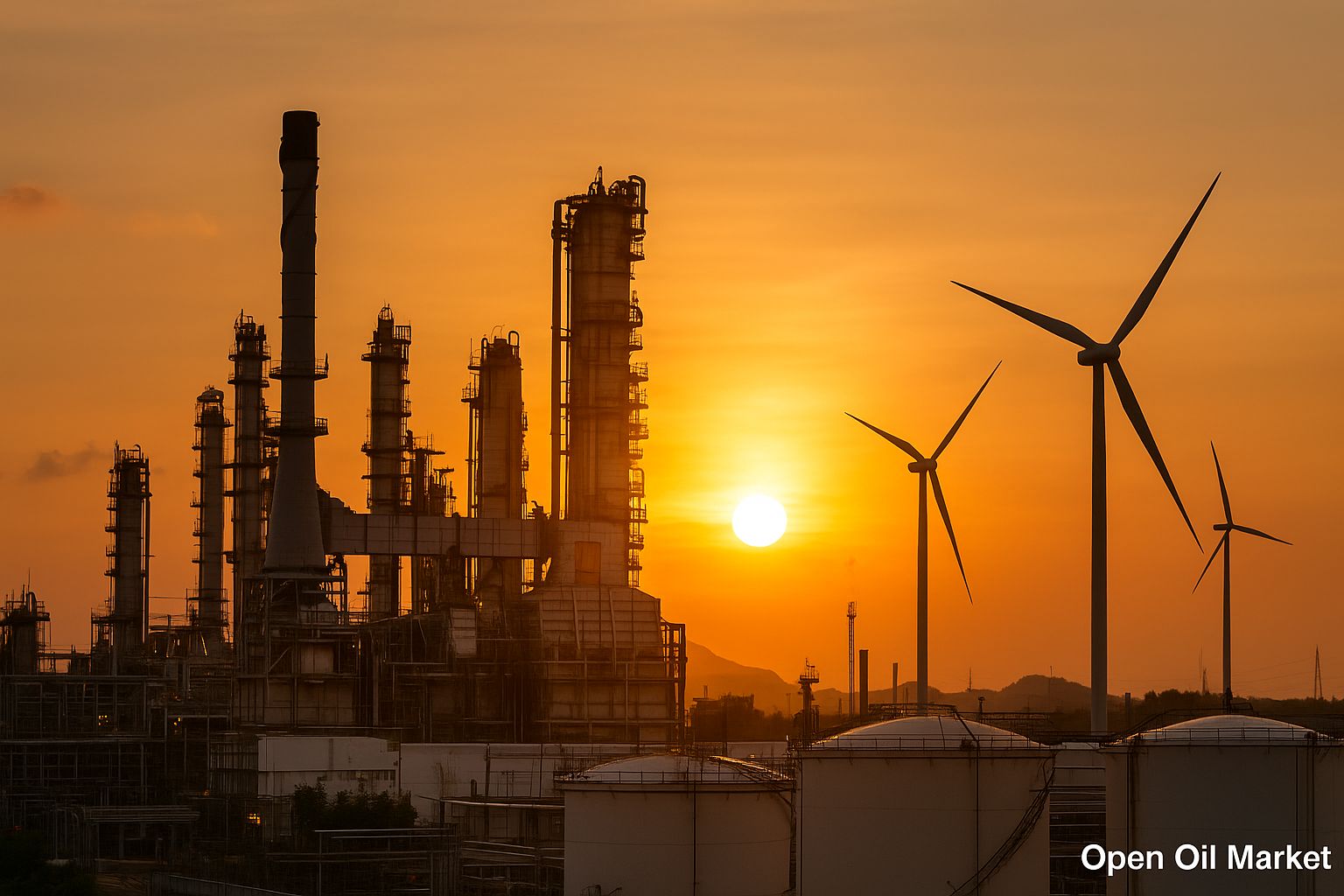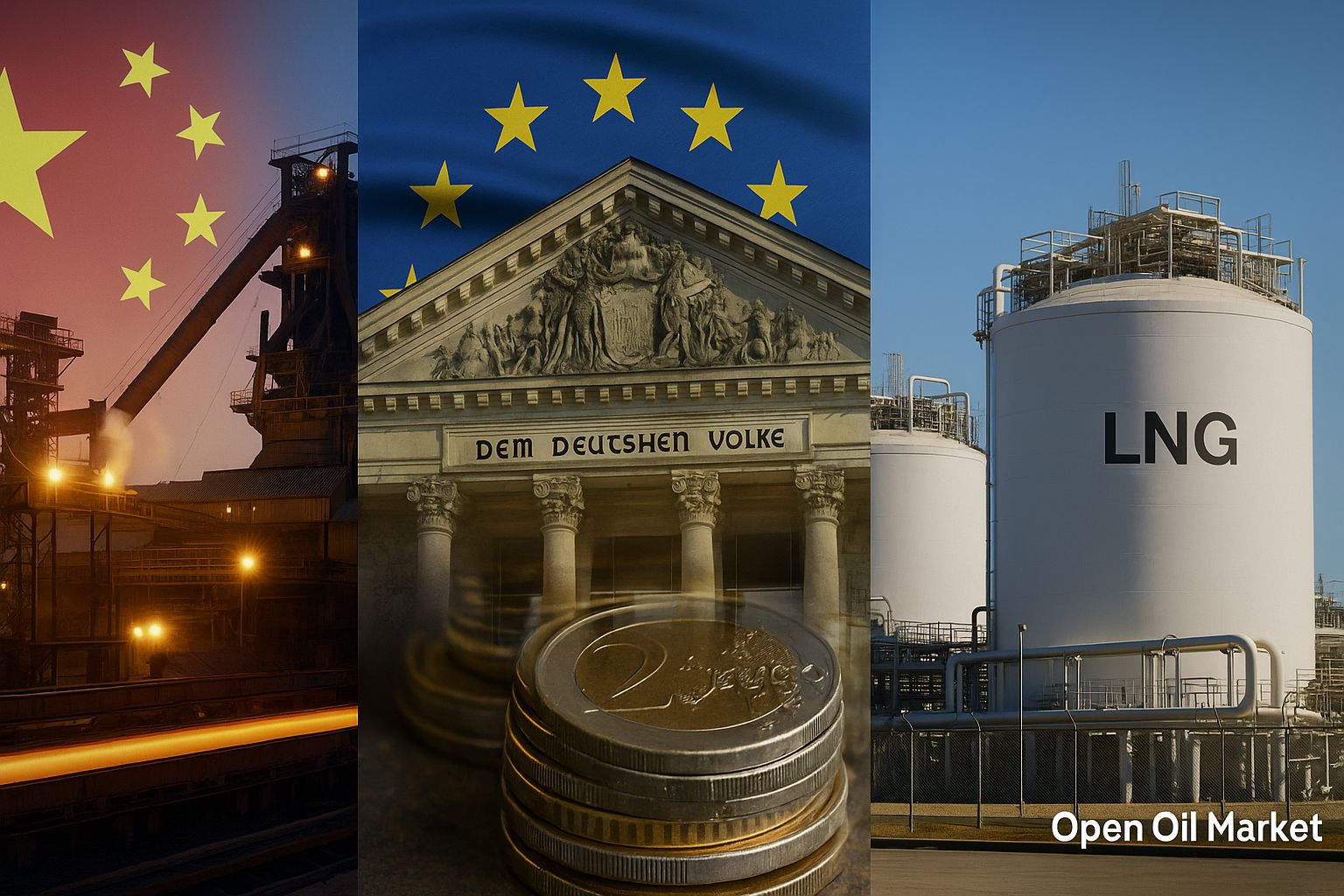
Current Oil Market News as of 10 November 2025: Oil Market Balance, Solid Gas Reserves in Europe, Renewable Energy Growth, Technological Trends, and Sanction Pressures. Analytics for Investors and Energy Sector Companies.
The global fuel and energy complex enters mid-November amid heightened geopolitical tensions and notable structural shifts in commodity markets. The sanction standoff between Russia and the West continues to impact the oil and gas industry: at the end of October, the United States expanded restrictions on major Russian oil companies, while the European Union approved another sanctions package, complicating international operations. Concurrently, the global oil market demonstrates a relative balance that leans towards oversupply: production remains at high levels while demand growth is slowing. The European gas sector approaches the winter season with solid, albeit not record-high, fuel reserves, instilling confidence in supply stability. At the same time, the energy transition is accelerating, with many countries recording new highs in renewable energy generation, although the variable nature of "green" generation still requires support from traditional sources. Below is a detailed overview of key events and trends in the oil, gas, electricity, and other segments of the energy market as of the current date.
Key Takeaways
- Oil: OPEC+ supply and record production in the US keep oil prices in a moderate range ($60–64 per barrel for Brent) despite ongoing geopolitical risks.
- Gas: Europe enters winter with high gas reserves (about 85% storage capacity), with diversified LNG imports compensating for reduced pipeline supplies, while price volatility is limited by weather factors.
- Sanctions and Geopolitics: New measures from the US and EU intensify pressure on the Russian energy sector, increasing risks and costs for export flows; companies and investors adapt through market and logistics reorientation.
- Asia: The largest developing economies (China, India) remain key drivers of hydrocarbon demand, balancing benefits from cheap supplies with energy security goals while simultaneously increasing investments in renewable energy.
- Electricity and Renewables: Global generation from renewable sources sets records in 2025, with accelerated construction of wind and solar plants; however, the issue of energy variability necessitates active development of storage systems and grid modernization.
- Fuel Market in Russia: Russia has extended temporary export restrictions on gasoline and diesel, which, along with measures to support refineries, stabilised domestic prices for oil products after a summer spike.
Oil Market: Balancing Supply and Slowing Demand
Prices. At the start of November, global oil prices remain at relatively low levels following a decline in the autumn. The benchmark Brent blend is trading in the range of approximately $62–64 per barrel, while the American WTI hovers around $59–60 per barrel. These levels are significantly lower than summer peaks, reflecting a shift in market balance towards surplus. Geopolitical factors (conflicts and sanction risks) add a modest premium to prices, but generally, market participants are moderately cautious.
- Supply: OPEC+ countries are gradually increasing production after previous restrictions. At an extraordinary meeting in early November, the alliance agreed to a symbolic increase in quotas (~+137,000 barrels per day from December), delaying more substantial growth until the first quarter of 2026. Simultaneously, US oil production has reached a record ~13 million barrels per day—thanks to the shale boom and easing environmental restrictions. High supply from OPEC+, the US, and other independent producers softens the global balance.
- Demand: Global oil consumption growth has noticeably slowed. According to the International Energy Agency (IEA), demand growth in 2025 is expected to be less than 1 million barrels per day (compared to more than 2 million in 2023). Economic slowdowns, particularly in China, high prices from previous years that stimulated energy conservation and improved efficiency, and accelerated adoption of electric transport are limiting the increase in oil consumption.
- Reserves: Commercial oil and product inventories outside OPEC have increased in recent months. In the US, significant replenishment of oil reserves has been observed in autumn, partly thanks to record production. Furthermore, some previously restricted sources are returning to the market, such as resumed export deliveries from the Kurdistan oil region (Iraq) after a long pause. The increase in reserves adds downward pressure on prices.
Outlook. The oil market concludes the year in a state of relative equilibrium, leaning towards oversupply. Without serious unforeseen events, prices are likely to remain within a moderate range until the end of the year. Concerns over possible supply disruptions or further tightening of sanctions prevent prices from collapsing; however, expectations of increased supply from OPEC+ and shale producers shape bearish sentiments. Oil sector companies are focusing on cost control and risk hedging, while refiners are striving to optimise product output (gasoline, diesel, aviation fuel) and logistics in a restrained price environment.
Gas Market: Europe Confidently Prepares for Winter
Situation in Europe. The natural gas market appears relatively stable, though the approaching winter keeps participants on edge. European countries have managed to stockpile substantial quantities of gas in advance: according to Gas Infrastructure Europe, storage facilities in the EU are approximately 85% full as of early November. While this is below nearly 100% year-on-year, it still provides a solid buffer in case of a cold winter. Diversification of supply sources has compensated for the reduction in Russian pipeline gas. Record imports of liquefied natural gas (LNG) from the US, Qatar, and other exporters support supply in the European market.
- Stocks and Import: The high level of underground gas storage combined with continuing LNG supplies means that Europe enters the heating season prepared. Weak gas demand in Asia during the first half of the year has also benefited Europe, allowing for the redirection of additional LNG shipments to European terminals.
- Prices: Thanks to reserves and alternative imports, wholesale gas prices in the EU remain significantly below the peak levels of 2022. In recent months, prices have fluctuated within a moderate range, responding mainly to weather changes. If winter is not excessively cold and competition from Asia for new LNG shipments remains moderate, the European gas market stands a good chance of navigating the season without price shocks.
- Demand and Generation: Efforts towards energy efficiency and the economic situation are constraining the growth of gas consumption in industry. Nevertheless, gas continues to play a key role in power generation as a balancing fuel: during dips in generation from wind or solar plants, the EU electricity sector is compelled to increase its share of gas (and at times coal) generation, as observed in the autumn during weak winds in Northern Europe.
Markets and Risks. Overall, the European gas market demonstrates resilience. Traders and energy companies are closely monitoring weather forecasts and LNG repair/supply schedules to respond promptly to balance changes. A key uncertainty remains temperature: prolonged frosts could increase the draw from reserves and push prices upwards. However, compared to previous years, Europe feels more confident due to accumulated reserves and diversified import routes.
Electricity: Supply Stability and Nuclear Renaissance
In the electricity sector, major markets maintain supply stability while governments focus on ensuring energy security amid the transition to clean energy. In 2025, several countries have ramped up support for base-load capacity: for instance, Japan has announced plans for the accelerated restart of idled nuclear reactors, aiming to reduce hydrocarbon imports and curb inflation. Similar nuclear renaissance is observed in other regions—more countries are considering nuclear generation and modern small reactors as a means to ensure power system reliability while achieving decarbonisation goals.
Concurrently, the modernisation of electrical grids and development of "smart" infrastructure for integrating the increasing share of renewables continues. Energy companies are investing in digital demand management systems and distributed networks to enhance electricity supply flexibility. In the short term, thanks to sufficient reserves of traditional generation (gas, coal, and nuclear power stations) and accumulated fuel stocks, the threat of electricity shortages this winter is minimal. However, the long-term trend of energy transition requires the sector to continuously balance the implementation of new technologies with the reliability of the grid.
Renewable Energy: Record Growth and Variability Issues
The renewable energy (RE) sector in 2025 demonstrates accelerated development. According to industry reports, global installed RE capacity has significantly increased: large solar and wind power plants are being commissioned from China and India to Europe and the US. Global generation from solar and wind has reached new milestones—the volume in the first half of 2025 has for the first time exceeded generation from coal power plants. Major energy companies and investment funds continue to direct record funds into clean energy projects, while governments stimulate the sector through targets and subsidies (for example, the UK plans to double clean energy jobs by 2030).
- Investments and Capacity: Annual investments in RE are setting new records, approaching $700 billion in 2024 and continuing to grow in 2025. Capacity additions have increased by more than 10% compared to the previous year. However, to achieve the global goal of tripling renewable capacity by 2030, adopted at the COP28 summit, this remains insufficient—experts urge for doubling annual RE construction and grid modernisation rates.
- Infrastructure Challenges: The rapid growth of RE share is revealing integration issues. In some regions in 2025, there have been periods where generation from wind and hydro plants dropped due to weak winds or droughts. To cover deficits, it was necessary to temporarily increase generation from gas and coal plants, which contradicts emissions reduction goals. These instances underscore the need for accelerated development of energy storage systems (industrial batteries) and construction of flexible backup capacities.
- Company Strategies: Oil, gas, and energy corporations are actively responding to energy transition trends. Many are increasing investments in solar and wind projects, bioenergy, hydrogen, and carbon capture technologies. Such portfolio diversification will allow them to remain competitive as the share of fossil fuels in the global energy system gradually declines.
Conclusion: Despite record progress, the world is still far from climate goals. The development of RE must be accompanied by infrastructure modernisation and new policy measures to overcome barriers and ensure sustainable sector growth without energy supply disruptions.
Coal Sector: Declining Demand and Price Stabilisation
The global coal market in 2025 is influenced by a long-term trend of decreasing coal's role in the energy balance. Analysts estimate that global coal consumption may decline by about 5–10% by the end of the year, as major economies gradually transition to cleaner energy sources. Decreased demand, especially from China for imported coal, coupled with overall market saturation, has led to a moderate decline in prices compared to last year's levels. Futures for energy coal have stabilised around $100–110 per tonne (for comparison, this is a quarter lower than in autumn 2024).
- Regional Features: In Europe and North America, coal use in energy continues to fall—old coal-fired power plants are being closed or retrofitted for gas and biomass as part of climate policy. In Asia, conversely, coal remains a significant fuel source: India and some Southeast Asian countries are still introducing new coal capacities to meet rising electricity demand. However, even there, appetites are being curbed—projects are increasingly being revised in favour of RE or gas.
- Export and Production: Major coal exporters (Australia, Indonesia, Russia, South Africa) have faced declining external demand. For example, US coal exports in the first half of 2025 fell by more than 10% due to reduced purchases by China and an overall surplus supply in the global market. Mines are scaling back production, focusing on lower demand to avoid excess inventories.
- Price Background: Following sharp price spikes in 2022 amid the energy crisis, the coal market in 2025 is relatively calm. Current prices, while rising by 5–7% over the last month due to seasonal demand increases, remain significantly below the record highs of the past decade. Equilibrium is maintained by quick adjustments in supply to the declining demand—several outdated capacities are being closed, preventing prices from falling too low.
Outlook. Looking ahead, the pressure from climate agendas will intensify: more countries are setting deadlines for phasing out coal generation (2040s for many developed nations). Meanwhile, developing economies are focusing on emissions cleaning technologies and gradually reducing coal's share. For investors, the coal sector is becoming a zone of heightened risk, although short-term price fluctuations may remain possible due to weather conditions and market dynamics in Asia (e.g., demand for metallurgical coal).
Oil Product and Refining Market: Stable Supply and State Regulation
The global oil product market at the end of 2025 is characterised by relatively stable prices and a sufficient supply level. Prices for gasoline and diesel have decreased compared to last year's peak, reflecting the lower cost of oil and the absence of acute shortages in major markets. At the same time, refining margins for refineries remain tight due to high costs and declining long-term demand for traditional fuels.
- Supply: New refining capacities coming online in the Middle East and Asia (including major refineries in China and the Gulf countries) have increased the global fuel supply. Simultaneously, several outdated refineries in Europe and North America have reduced processing or closed due to low profitability and environmental requirements. In general, global refining capacities slightly outstrip demand, ensuring adequate supply of gasoline, diesel, and jet fuel in the market.
- Demand: Gasoline consumption is stagnating or declining in developed countries as the electric vehicle fleet grows and fuel efficiency of internal combustion engine vehicles improves. The demand for diesel fuel also faces structural pressure—more efficient technologies and alternatives are being adopted in transportation and industry. The only segment showing recovery is aviation fuel (kerosene), where consumption is increasing with the revival of international flights, although it has yet to reach the levels seen in 2019.
- Regulation in Russia: In Russia, the policy of strict control over the domestic oil product market has continued into autumn 2025. The government extended the temporary ban on gasoline exports until the end of the year (with the possibility of extension into 2026), and restrictions on diesel exports remain in place—exports are permitted only when fully ensuring the domestic market. Additionally, the price dampening mechanism for refiners has been adjusted: the price threshold has been increased, above which payments decrease, thus reducing the benefit from exports under high global prices. Additional fuel volumes have been directed from reserves to regions experiencing shortages during the summer to normalise the situation.
Results. The measures taken have allowed for the stabilisation of fuel prices in Russia during autumn. Wholesale prices for gasoline and diesel, which peaked in August, have fallen and are maintaining a narrow range. Retail prices have stopped rising sharply, though they still remain above last year's levels. With improved supply to gas stations and the completion of the harvest, tension in the domestic fuel market has eased. Experts note that if current oil prices persist, the government could gradually relax export restrictions in early 2026, but only if the domestic market is fully saturated and consumer prices show a sustainable decline.
Technological Trends in Energy: Electric Vehicles, Hydrogen, and Digitalisation
Technological progress continues to transform the fuel and energy complex, shaping the direction of development for years to come. One of the key trends remains the mass adoption of electric transport. In 2025, sales of electric vehicles and hybrids are breaking records: according to industry analysts, in September, monthly global sales of electrified vehicles exceeded 2 million units, which is a quarter more than the previous year. China and Europe are leading in the pace of transport electrification, and by the end of the year, the share of electric vehicles may exceed 20% of all cars sold. The rapid growth of the electric vehicle fleet is already beginning to impact motor fuel demand—especially gasoline—in several countries.
Another strategic focus is the development of hydrogen energy and infrastructure. Governments and major energy corporations are investing in "green" hydrogen projects: electrolyser capacities are being built, and supply chains are being established for the use of hydrogen in industry, transport, and energy. Europe has a programme for the establishment of hydrogen hubs, the Middle East is implementing projects for exporting ammonia and methanol based on hydrogen, and in China and Japan, hydrogen fuel cells are being rapidly adopted in transport. Although hydrogen currently occupies a minor share in the balance, 2025 has marked the launch of several commercial hydrogen projects, bringing this technology closer to widespread application.
Digitalisation and innovations are also changing the landscape of the industry. Oil and gas companies are actively implementing artificial intelligence and big data analytics to enhance efficiency: these tools optimise extraction at fields, predict equipment wear, and improve trading of energy resources on exchanges. "Smart" energy systems, including intelligent grids and energy storage devices, allow for smoothing out demand peaks and integrating more renewables without compromising reliability. Advancements in battery technologies continue to lower the cost of energy storage—large lithium-ion and sodium-ion batteries are being installed to balance energy systems in the US, Europe, and Australia.
Looking Ahead. Current technological trends indicate that in 5–10 years, the structure of energy resource demand will change significantly. Electric vehicles could notably reduce consumption of oil products in transport, hydrogen has the potential to carve out a niche in heavy industry and freight transport, and digital solutions will enhance the flexibility and efficiency of the entire energy system. For energy companies, adapting to these changes has become a necessary condition for competitiveness: by investing in new technologies today, they are laying the foundation for sustainable growth in the future, even amid energy transition and tightening environmental regulations.




